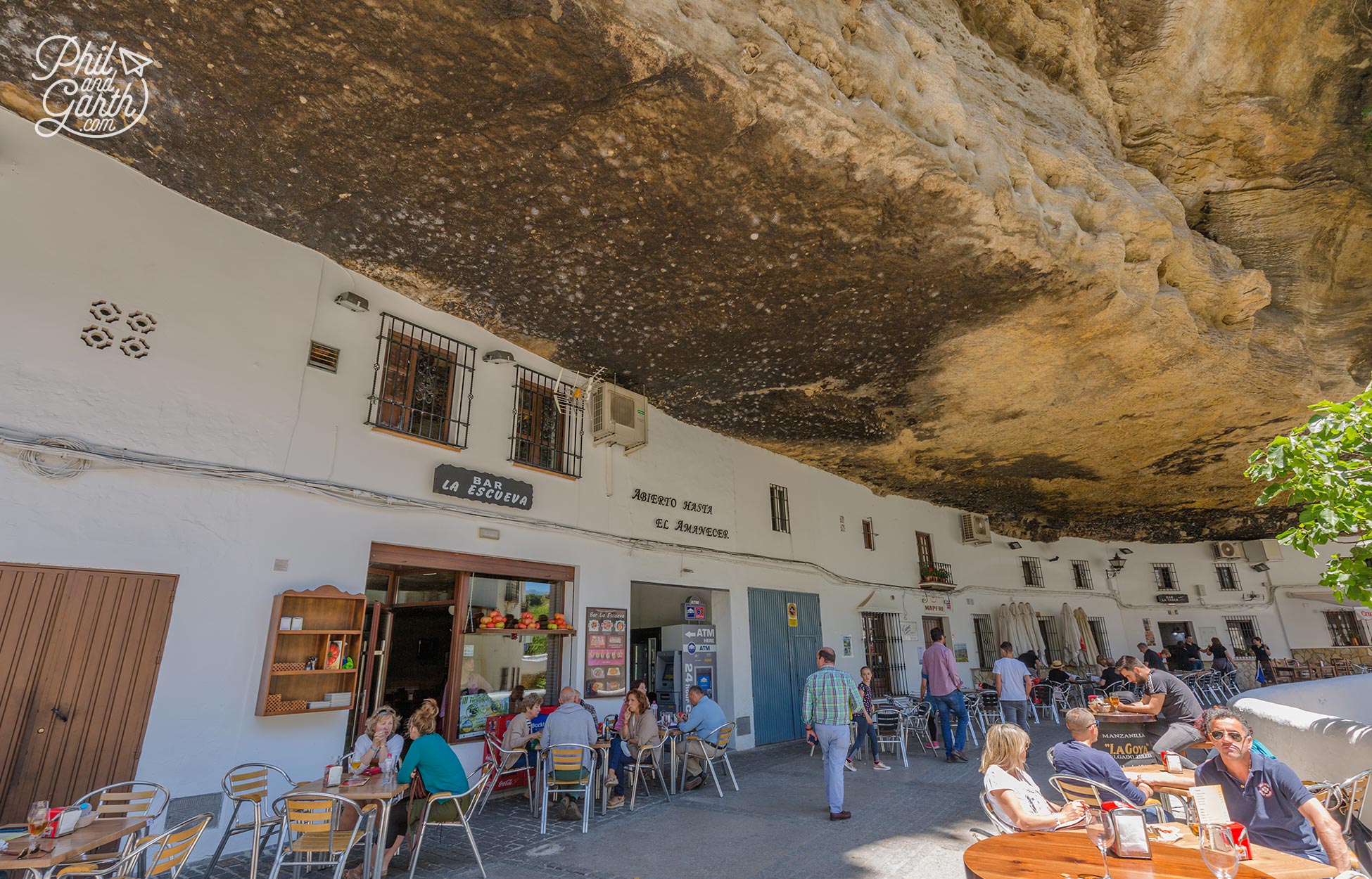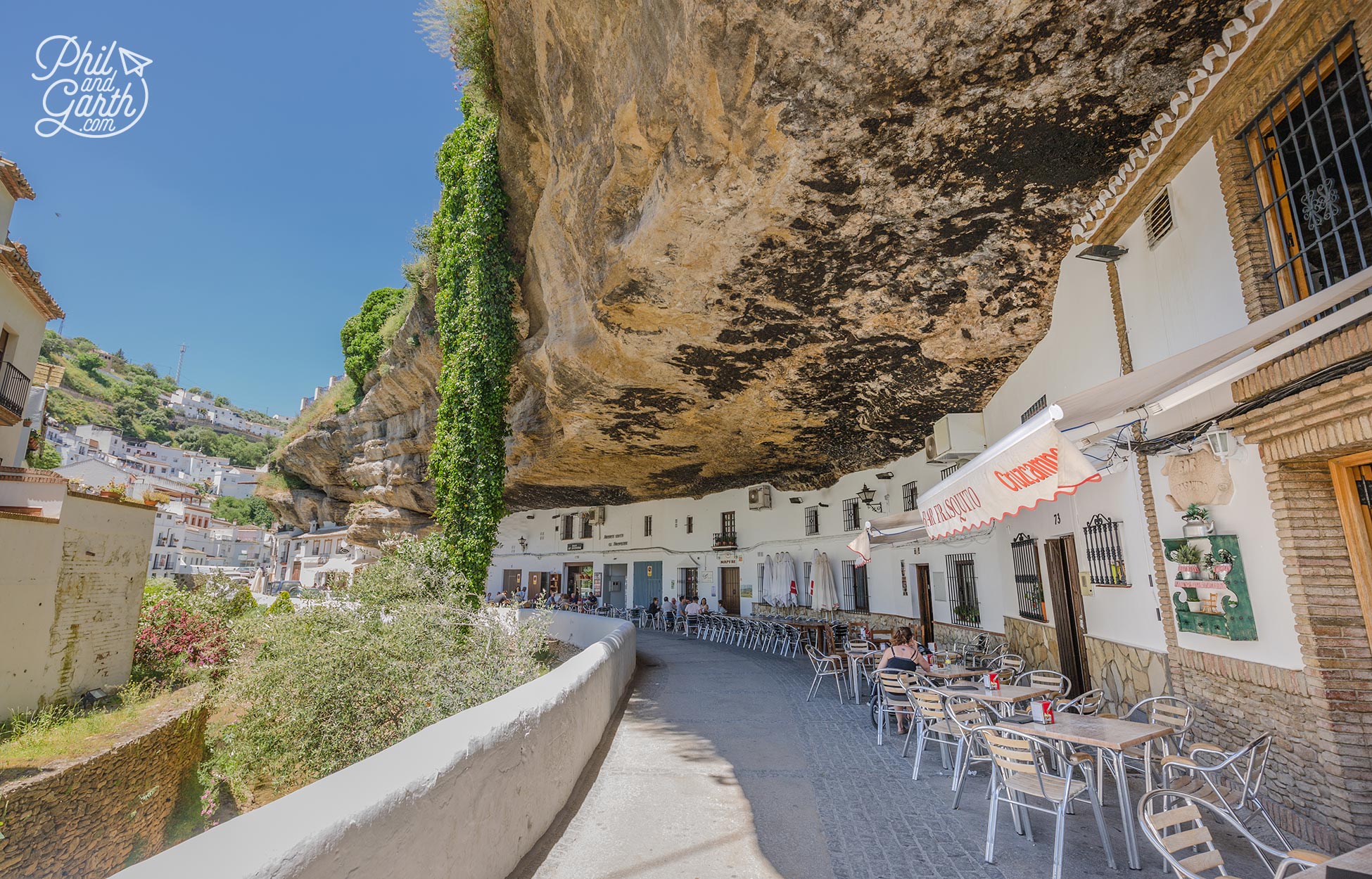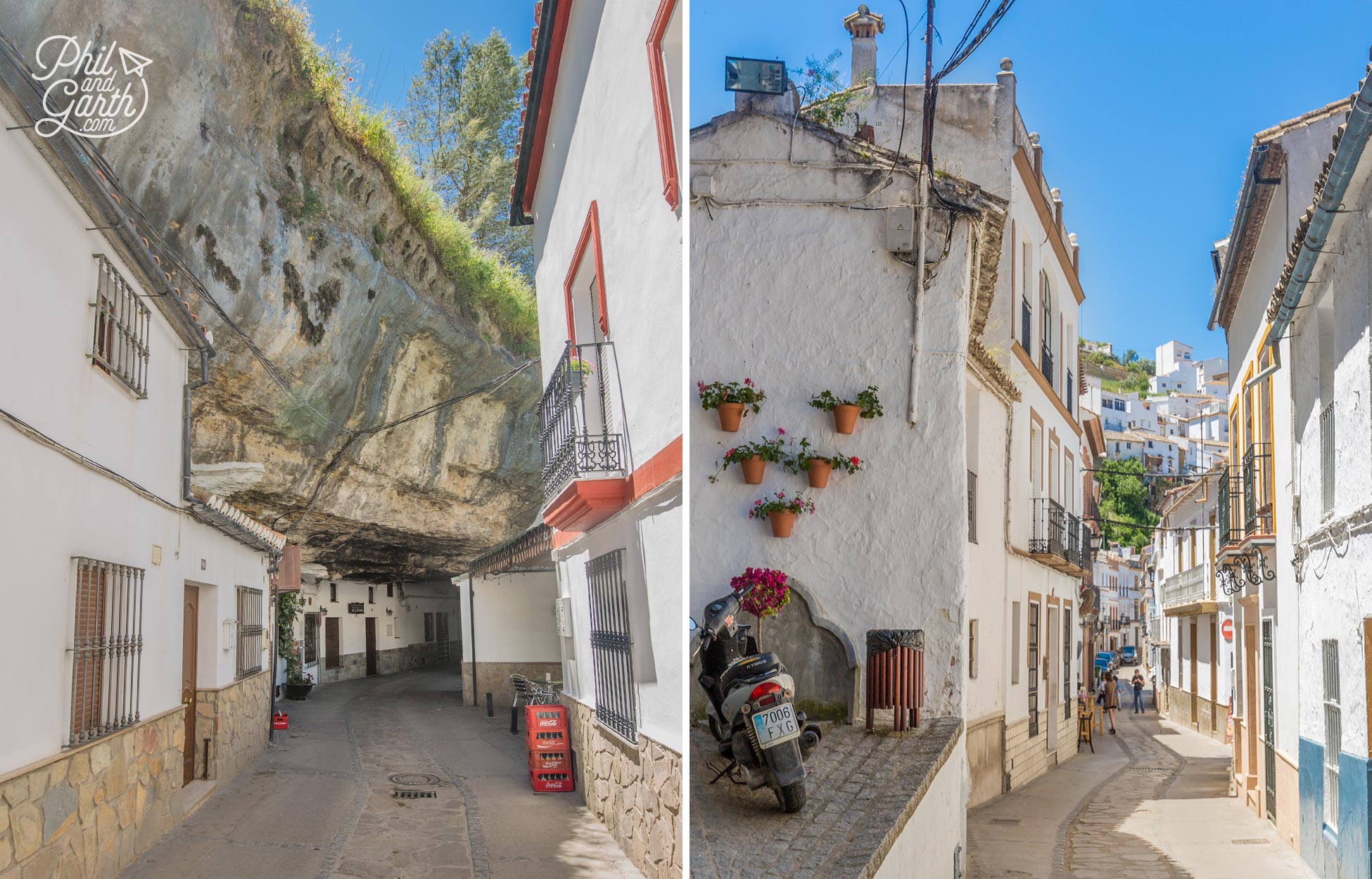Last updated: 7th January 2022
Whilst staying on the southern coast of Andalusia we decided to take a day trip to Setenil de las Bodegas after hearing it was Spain’s unusual town that lives under a rock! so we had to check it out. In this post we’ll show you what to see and do on a day trip to Setenil de las Bodegas.
Table of Contents
About Setenil de las Bodegas
You may have heard of Southern Spain’s ‘White Towns’ of Andalusia, characterised by their hilltop locations and ridiculously pretty white washed homes. Well Ronda is probably the most dramatic of these towns but did you know just 30 minutes away lies another equally striking White Town? It’s called Setenil de las Bodegas – a unique place where people live under rocks. It’s an extraordinary sight where many of the town’s homes are built underneath huge rock overhangs. About 3,000 people live here some in these ancient caves where it’s believed the first residents arrived 12,000 years ago during the Stone Age, then through to Roman times. However when the Islamic Moors arrived 1,300 years ago they built a modern fortified town with a castle and also took advantage of the cool caves and areas under the rock to store goods. Today you can visit the restored tower of the old castle they built.
Attractions of Setenil de las Bodegas
There are two main streets to explore – ‘Sun Street’ and ‘Shade Street’ which run parallel to each other on the banks of the River Guadalporcún that runs through the town.
It’s astonishing looking at the homes sculpted directly in the rock, they are not actually carved into the rock, instead people have built just a front wall – a facade under the natural overhang with the caves forming the interiors of their homes. Sun Street is lined with various restaurants and tapas bars. It’s worth taking a peek inside some of the bars to see these surreal interiors – the rock is their ceilings and walls, we thought some of the bars looked like pubs straight from medieval times!
Sun Street – Cuevas del Sol

The extraordinary appearance of Setenil de las Bodegas

‘Sun Street’ Cuevas del Sol in Setenil de Las Bodegas

Take a peek inside some of the bars to see the surreal interiors

Our dramatic setting for lunch

Gravity defying buildings embedded into the rock on ‘Sun Street’
We sat outside Bar Frasquito for lunch and ordered a few tapas dishes including a plate of fried fish, nobody spoke English so we tried our best pigeon Spanish! What arrived was huge portions and very generous for what we thought were tapas dishes because they were reasonably priced, oh well we still managed to scoff everything! whilst watching the birds flying around the overhanging vines.
Shade Street – Cuevas de la Sombra
Cross over the river and you’ll find ‘Shade Street’ there’s lots of nice craft and foodie shops to browse around here. Part of the street is more like a tunnel where giant boulders create a natural ceiling.
Make sure you stop at the deli shop – La Cueva del Iberico, it’s inside a cave where we took advantage of the free cheese and wine samples. Apparently Setenil de las Bodegas is famous for chorizo and wine, we also saw places selling marmalade, must be because of all the juicy oranges grown in this region.

La Cueva del Iberico situated on “Shade Street” Cuevas de la Sombra

Loads of Iberian hams for sale in La Cueva del Iberico

Charming streets to wander around near ‘Shade Street’

Strike a pose!
Calle Jabonería
Once you’re done with Sun and Shade streets walk down Calle Jabonería which leads you to a Roman Bridge. Along the way it’s a delight just wandering the narrow streets, every nook and cranny has been filled with a home. Buildings are painted white to reflect the scorching summer sun to keep temperatures inside cool. The quirky homes are so picturesque, especially with potted geraniums decorating doorways. Oh and if you love taking photos of doors, then you’ll be in your element! there’s lots of old ones to choose from.

Homes built into the rock in Setenil de las Bodegas

A tiny house built into the rock face

White washed homes in Setenil de las Bodegas

One of the many little bridges

Flower filled pots add a splash of colour to white walls

Love the decorative painted pots!
Just like many of Andalusia’s white towns, Setenil de las Bodegas has been occupied by the Romans, Moors and Christians over time and the architecture reflects this, we passed an old mosque that had been converted into a church.
Don’t worry about getting lost, that’s part of the fun, there are signs up with a camera icons pointing you to certain streets if you get stuck. We loved soaking up the peaceful atmosphere of this authentic Spanish town.

An old mosque converted into a church

The smell of Geraniums is in the air

Wandering the streets of Setenil de las Bodegas
Castle Tower and Church
End your visit to Sentil de las Bodegas by heading up to the highest point to see the restored Nazarí Tower. It’s the only remaining tower of the former Moorish castle, next door you can also visit the imposing Church of the Incarnation.
It’s a steep walk to the top in places but worth the effort, on your way up make sure you find Calle Herrería, the town’s oldest street which leads to Plaza de Andalucía – a picturesque square which has a couple of restaurants. We tried to order some coffee on some of the outside terraces, but told we could only stay if we ordered food.

The Moorish Nazarí Tower, now restored and modernised

Calle Herrería is the oldest street in Setenil de las Bodegas

Pretty Plaza de Andalucía
White Towns (Pueblo Blancos) of Andalusia
We loved visiting Setenil de las Bodegas, it must be the most unique of Andalusia’s White Towns or ‘Pueblo Blancos’. It would make a great day-trip if your staying in popular Malaga or Cadiz. Or if you’re staying in Ronda then it’s definitely worth a detour as it’s so close, a 30 minute drive or there’s public transport buses. You’l pass some amazing olive farms and valleys on the way.
If you are staying even longer and have a car then you should consider taking a mini road-trip around more ‘Pueblo Blancos’. Built on protective hilltop locations in this mountainous region of Andalusia (the Cadiz and Malaga provinces) Theses traditional towns are authentic Spain and that’s why you should try and see them. Others worth exploring include:
-
-
- Ronda – Perched on a somewhat terrifying but spectacular huge gorge.
- Casares – Has a huge Moorish Castle and Roman baths.
- Antequera – Lots Baroque art, described as ‘The Heart of Andalusia’
- Mijas Pueblo – Famous for burro taxis (donkey taxis)
- Gaucin – Views to Gibraltar and the Rif mountains of North Africa.
- Ubrique – Famous for high quality leather goods.
- Grazalema – It’s the whitest of the white towns.
- Zahara de la Sierra – Views of green valleys and turquoise lakes below.
- Arcos de la Frontera – Dramatic setting and not overly touristy.
- Olvera – Imposing Church and Moorish Castle, also sells the region’s best virgin olive oil.
- Vejer de la Frontera – Lots of Islamic influences here, it has a Moroccan vibe.
-
Setenil de las Bodegas Practical Information & Useful Advice

Phil and Garth in Setenil de las Bodegas
Phil and Garth’s Top 5 Setenil de las Bodegas Tips
- Tip #1: Don’t even attempt to drive into the town as you will get stuck – park just outside and walk in.
- Tip #2: Take a photo of the map near the bus station so you can refer to it as GPS on Google Maps is hit and miss.
- Tip #3: It’s not a very practical place to explore for the elderly or wheelchair users because of the steep steps.
- Tip #4: If you have a DSLR take a wide angle lens or use a GoPro to get the best pics on Sun and Shade Streets.
- Tip #5: Don’t expect everyone to speak English as they don’t, so brush up on your Spanish phrases!
Setenil de las Bodegas Fast Facts
- Airport Code: AGP – Málaga Airport is the closest airport to Setenil de las Bodegas, 59 miles away.
- Time: GMT +1 hour. Central European Standard Time.
- Currency: Euro (symbol: €)
- Language: Spanish.
- Population: 3,016.
- In An Emergency – General number is 112 or 091 for police, 061 for ambulance and 080 for fire brigade.
- Electricity: Socket type C & F. Both take the standard 2 Euro pin plug. Voltage is 230V / 50Hz.
- Best Time To Visit Setenil de las Bodegas: March to June and September to November. June is the driest month.
- Worst Time To Visit Setenil de las Bodegas: July to August will be very busy and very hot.
- Famous For: Spain’s hidden town living under a rock.
- History: Setenil de las Bodegas dates back to the Stone Age. It was developed in the 12th century by the Islamic Moors.
- 5 Must See: Sun Street, Shade Street, Castle, Calle Jabonería and Plaza de Andalucía.
- Local Food: Have chorizo and wine underneath the rock at one of the tapas bars.
- Getting Around: Setenil de las Bodegas is small enough to walk around.
- Trivia: ‘Bodegas’ means wineries, referring to a time when the town once had vineyards.
- Best Photo Spot: The Compania Mar Oceano look out point (mirador) has amazing views.
- Hidden Gem: 10 minute drive from Setenil de las Bodegas is ancient Acinipo with the remains of a Roman theatre.
- Souvenir: A jar of local marmalade.
Pin our Setenil de las Bodegas travel guide for later







12 comments
Wow! What a wonderful place! I’d never heard of it before but it sounds magical. Thank you for sharing your beautiful photos and top tips for a visit. We need to dust off our Spanish and get booking our flights
Whoa, this place is too cool! Must add it to our list!
I’d love to see more of Andalusia’a White Towns but this one surely has to be first. I’m always fascinated by places that work around their setting and the houses under that rock ledge are truly fascinating! Stunning photos as always!
I´ve been to Andalusia so many times and still haven´t seen all of its ‘White Towns’! Although I did visit Setenil de las Bodegas – such a unique place indeed! We didn´t spend much time there, cause as you mention, it´s a lot about stairs and we had a baby and a stroller. I´m also surprised by the fact they don´t speak English – I mean, they basically live from international tourism in Andalusia!!! Although after all these years of living in Spain and traveling across the country I should have gotten used to it!!!! lol #FeetDoTravel
What an interesting town! It reminds me of the ancient cities in the Southwest, built in rock crevices; though at this time they are all only ruins. I never knew a place like this existed. Now I need to go visit it. I’d love to get lost there (not that I could from the sound of it). Thanks for sharing; gorgeous photos, by the way.
How did I miss this! Nothing else for it I shall have to return to the white towns!
The rocks serve their purpose in Setenil de las Bodegas. I’ve never seen anything quite like this town. I am wondering if they use the rock as the back wall in their businesses and homes. Also, thanks for the tips, It’s important to know ahead of time that no one speaks English. #FeetDoTravel
The Pueblo Blancos are on the list now, especially Setenil de las Bodegas. I love the simplicity of naming Sun & Shade Streets. You know exactly what to expect. Pinned to use for planning! 🙂
I’ve seen this place on IG, but it’s so nice to learn more about the town and now I DEFINITELY want to go and it’s been added to the top of my Andalusia road trip itinerary for the future! Interesting to learn why they paint the buildings white! And I love how you included a list of other white villages in the region! #FeetDoTravel
Wow, what a cool town! I had no idea this existed, but it looks like a fascinating place to explore.